Review of the Osennyaya Yakovleva pear variety: advantages, disadvantages, nuances of cultivation
Autumn-ripening pears are especially popular in our latitudes. The fruits are stored in a cool room until late autumn. Today we will talk about one of these - the Autumn Yakovleva pear. This variety of domestic selection is grown in the Black Earth Region and the regions of the middle zone.
The plant is characterized by a high level of drought resistance, stable fruiting and excellent taste of the fruit.
History of origin and distribution of the variety
Osennyaya Yakovleva pear is an autumn-ripening variety that was bred by crossing the varieties Daughter of Blankova and Bergamot Esperen. The work was carried out by breeders P. N. Yakovlev, S. P. Yakovlev and Z. N. Tsvetaeva - employees of the All-Russian Research Institute of Genetics and Selection of Fruit Plants named after. I. V. Michurina.
The first tests were carried out in 1949. The variety has been approved for cultivation since 1974 Voronezh, Kursk, Volgograd regions and is most widespread in the regions of the middle zone.
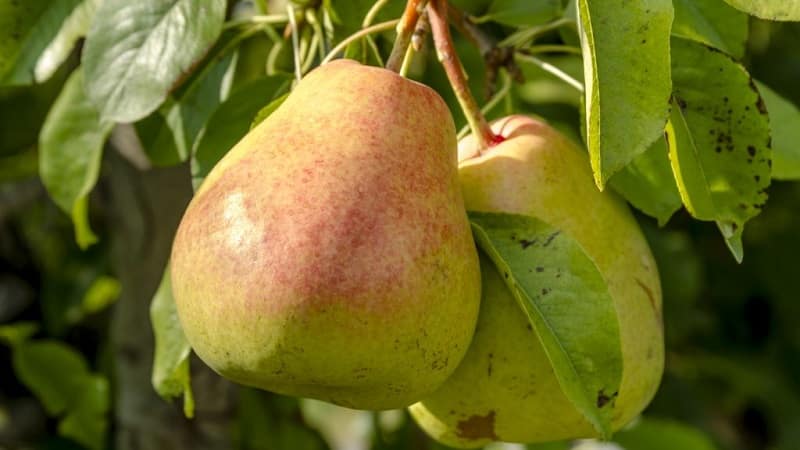
Description and characteristics
The trees are tall (about 15 m) and fast growing. The crown is sparse and spreading. The branches droop slightly as they grow. The shape is highly rounded or broadly pyramidal.
Shoots are curved, dark brown, medium thickness, lentils are few. The leaf blade is wide, slightly curved, medium in size, pointed at the tip. The base of the leaf is wedge-shaped, directed upward. The edges are jagged.The petioles are long, the stipules are subulate.
Variety has a high ability to shoot formation — after pruning, the crown thickens greatly.
Fruits are formed on fruit rods and ringlets, have a ribbed, broadly pear-shaped or irregular rounded-diamond shape. Average weight - 130-150 g, maximum - 250 g.
Fruits of medium ripeness are green, with a slight blush on the sunny side. Fruits of technical ripeness have a green-yellow color. The top coat color runs along a narrow part in the form of a vague carmine blush. Large brown dots are visible on the skin.
The stalks are of medium thickness and length, straight. The funnel is wide, without rust. Open cup. The saucer is shallow, wide, ribbed. The heart is oval, wide.
The seeds are large, ovoid, light brown in color., with closed seed chambers.
The pulp is oily, dense, non-grainy. The aroma is weak. The taste is melting, juicy, tender, sweet, without astringency, with a slight aftertaste of nutmeg. Tasting score - 4.8-4.9 points on a five-point system.
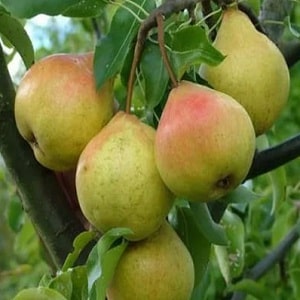 Biochemical composition of the fetus:
Biochemical composition of the fetus:
- sugar - 9%;
- acidity - 0.08%;
- vitamin C - 12 mg;
- catechins - 38.8 mg.
The fruiting period begins 5 years after planting, however, there is information about later dates. The fruits are used universally: wines, preserves, jams, marmalade, compotes, candied fruits. The harvest is harvested in the second half of August and stored in the cellar until the end of October. Productivity - 30-35 kg per tree.
The level of winter hardiness is low - up to -25°C. Drought resistance is high. The variety is prone to fruit scab.
Autumn Yakovleva is used in breeding work. With her participation, the Debutante pear variety was developed, zoned in the Middle Volga region.
Interesting things on the site:
Step-by-step instructions for planting cherry plum in autumn
Advantages and disadvantages
Advantages of the variety:
- high taste qualities;
- drought resistance;
- productivity;
- stable fruiting;
- keeping quality;
- vitamin content.
Flaws:
- susceptibility to fruit scab;
- tallness;
- late fruiting;
- the need to trim the crown.
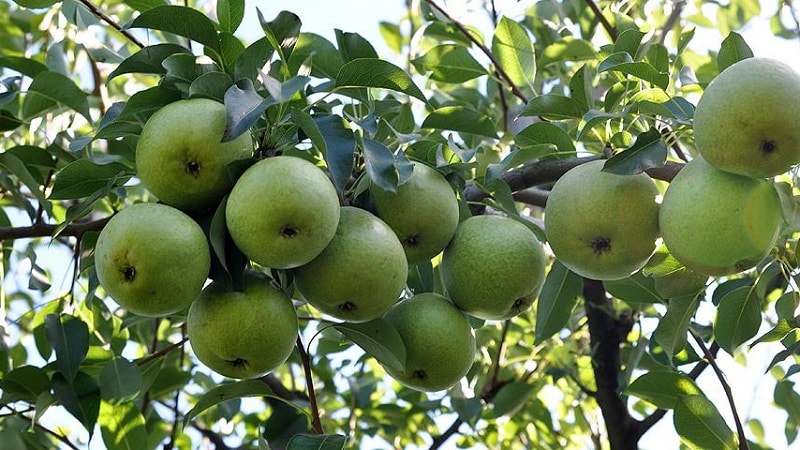
Preparation of planting material and soil
When cultivating the variety, standard pear farming techniques are used.. It is preferable to plant in the spring. When planting in autumn in the regions of the middle zone, there is a high probability of unrooted seedlings freezing in winter.
The site is chosen on the sunny side, without drafts, with deep groundwater. On the north side, trees should be protected from piercing cold winds by the dense crown of neighboring trees or the wall of the house. At the same time, it is not recommended to place seedlings in close proximity to fences or trees so that they do not end up in the shade.
The soil must be moisture- and breathable, fertile. Black soil or loam with an acidity level of pH 5.5-6 is best suited. The plant does not develop well in alkaline soil.
Seedlings can be purchased in the spring, but in the fall the choice is much wider. This is explained by the fact that nurseries dig up seedlings en masse in the fall. In the spring, unsold copies that were left for storage go on sale.
A high-quality seedling has a well-developed root system, smooth bark without cracks. The optimal age is 1-2 years. Old seedlings do not take root well; later they begin to grow and bear fruit.
Seedlings purchased in the fall are buried in the ground until spring for better preservation.. In the garden, they dig a rectangular hole, up to 30 cm deep, pour river sand on the bottom and lay the plant with the rhizome down. The top is placed on the edge of the pit. Before this, the roots are dipped in a solution of mullein and clay, then covered with sand and watered. With the arrival of cold weather, the hole is filled with soil.
Seedlings can be stored in basement at a temperature of 0…+5°C.
Landing technology
Tall trees with spreading branches need space for full development. Recommended planting pattern: 4-4.5 × 5-6 m.
The pit for planting trees is prepared in the fall. Its size depends on the fertility of the soil. The lower the soil nutritional value, the larger the hole. On loam, a depression is formed with a diameter of 80 cm and a depth of 70-80 cm. On sandy soil, a hole is dug with a diameter of 1 m and a depth of 2 m.
The bottom is compacted with crushed stone, broken brick, expanded clay to prevent water stagnation. The thickness of the drainage layer is 10-15 cm.
A nutrient mixture of peat, chernozem, sand and humus (1:1:1:1) is added to the hole., add 300-400 g of superphosphate and 3-4 liters of wood ash. The pit is covered with roofing felt, slate or thick film to prevent the nutrient mixture from being washed out by melt water in the spring.
In the spring, seedlings are dug up or taken out of storage, carefully examined and immerse the roots in a solution of “Kornevin”, “Heteroauxin”, “Epin” to stimulate the formation of new roots.
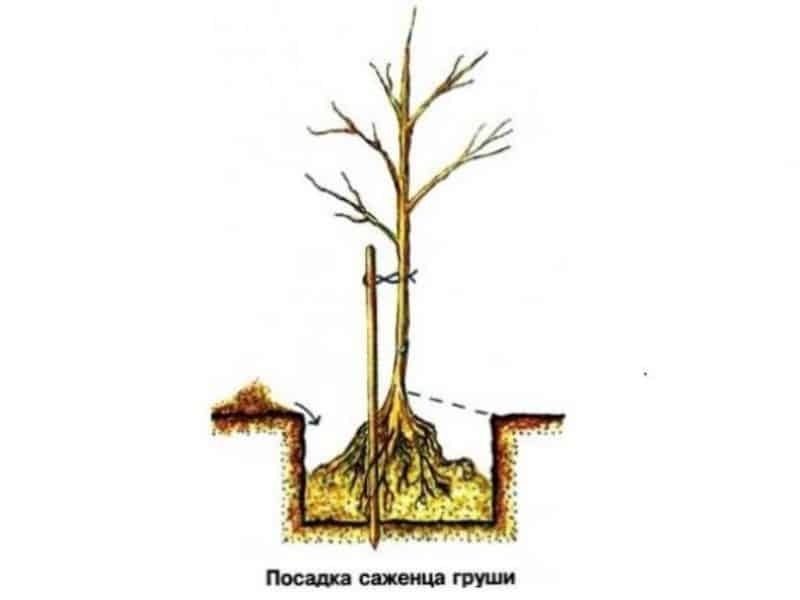
The cover is removed from the pit, in the center a depression is formed according to the size of the rhizome and a slight elevation is made. A stake 1-1.3 cm high above the ground level is driven in 15 cm from the center.
The seedling is lowered onto a hill with its root collar, and the roots are spread along the slopes. Soil is poured on top.Each new layer is compacted. The root collar should be at ground level.
After filling the hole, the seedling is tied to a peg with an elastic rope. It is important not to squeeze the bark.
A shaft is formed around the pit 25-30 cm high to retain water when watering.
After planting, the seedling is watered abundantlyso that air bubbles come out and the earth adheres tightly to the roots. After the soil has dried, the top layer is loosened and covered with sawdust, spruce branches, compost, and straw. Mulch layer - 6-8 cm.
The central conductor of a young tree is trimmed to a height of 60-80 cm, branches are shortened by 50%.
Growing and care
Standard agricultural technology for pears: watering, pruning, fertilizing, disease prevention.
Watering is carried out regularly - once every 25-30 days. The first time the pear is watered is before flowering, the last time - in October. The soil is spilled to a depth of 25-35 cm. The trunk is hilled to prevent direct contact with water. This way it is possible to protect the root collar from rotting.
The soil is loosened after each watering and rain for better saturation of the root system with oxygen.
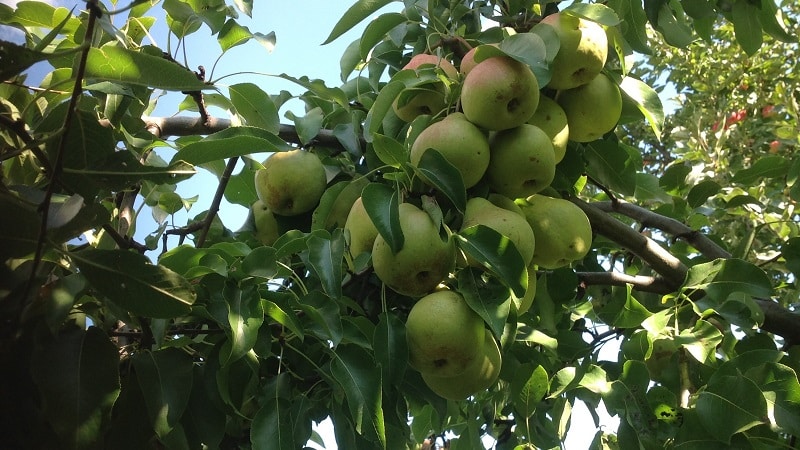
Mulching retains moisture and reduces the frequency of watering and loosening. The mulch layer is regularly checked and updated - this is an ideal environment for the accumulation of beetles and slugs.
The nutrient mixture in the planting hole is depleted after 3-4 years after landing. Fertilizing begins annually, using organic matter and minerals.
Feeding scheme:
- Compost, peat and humus are added in the spring for digging every 2-3 years. For 1 m² of tree trunk circle use 5-7 kg.
- Nitrogen-containing fertilizers (ammonium nitrate, urea, Nitroammofoska) are applied annually in an amount of 20-30 g/m².
- During the period of active growth of shoots and fruits, trees are fed with potassium sulfate or monophosphate in an amount of 10-20 g/m².
- Superphosphate is added in the fall for digging - 20-30 g/m².
- To support fruiting, trees are fed with a solution of mullein or chicken manure: 2 liters of liquid fertilizer are poured into 10 liters of water and left for a week in a warm place to ferment. Fertilizer consumption is 10 liters per 1 m² of tree trunk circle. Instead of mullein, green fertilizers are used (infusion of nettles, weeds, tops, any grass): 5-7 kg of raw materials per 10 liters of water.
The crown is pruned in March. This procedure is performed to delay the growth of branches and stimulate the growth of buds and fruits.
Important! At the end of April, trees are sprayed with Fury and Inta-Vir to prevent fungal diseases and the spread of pests.
The standard crown formation for tall trees is sparsely layered. An annual seedling is pruned to 70 cm. In the next season, a first tier of 3-4 shoots 45-50 cm high is formed. Over the next two years, a second tier of 2-3 frame branches is laid at a height of 35-40 cm from the outermost branch of the first tier. If necessary, form a third tier of 1-2 branches. After 5 years, you should get a crown of 6-8 frame branches.
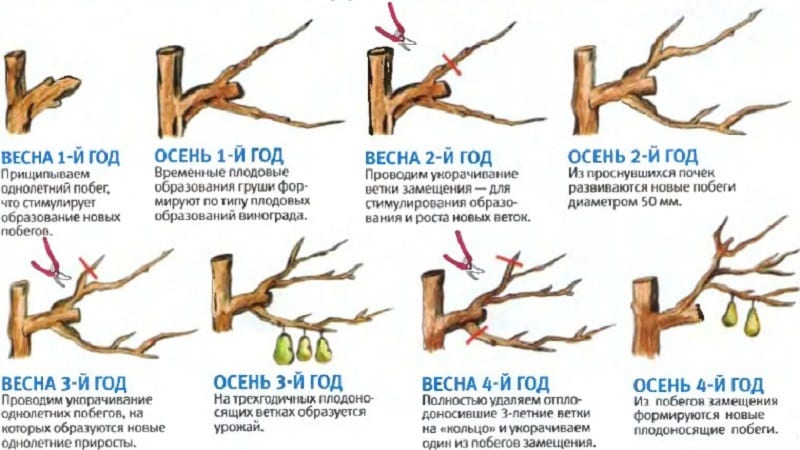
There are other types of pruning:
- sanitary (removal of dry, diseased and damaged branches);
- regulating (thinning);
- supporting (shortening the length of branches to stimulate fruiting).
The last type of pruning is performed by the chasing method (shortening young shoots by 5-10 cm) or by forming shoots that replace fruiting branches.
General pruning requirements:
- The pruning tool (hacksaw, pruning shears, lopper, knife) must be sharp.
- Before starting work, the instrument is disinfected with a 1% solution of copper sulfate, 3% solution of hydrogen peroxide, 3% solution of potassium permanganate, alcohol (optional).
- After pruning, hemp and branches should not be left open - after drying, putrefactive processes develop and a fungal infection occurs. Experienced gardeners advise using the “ring” technique. The branch is cut with a hacksaw from below to 1/3 of the thickness, 25 cm away from the ring. Next, the tool is shifted 2-3 cm to the side and sawed from above. After removing the branch, the stump is sawed off along the top of the ring. A torn, uneven cut is cleaned with a knife - a smooth one heals faster. The saw cut is disinfected with brilliant green or the biological preparation “Farmayod” and covered with wood paint based on lanolin or beeswax.
Read also:
Protection from diseases and pests
To minimize the risk of fungal and bacterial infections and insect attacks, apply prevention methods:
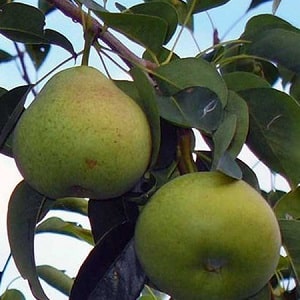 removal of weeds and plant residues;
removal of weeds and plant residues;- destruction of infected trees and their parts;
- plowing the soil to a depth of 20-25 cm;
- treatment of damaged bark with fungicides;
- autumn whitewashing of frame branches and trunks with slaked lime or copper sulfate;
- spring installation of catching belts on boles;
- spraying with fungicides and insecticides.
The Osennyaya Yakovleva variety has an increased risk of scab infection, especially during the period of mass distribution. High humidity and cold weather promote the spread of fungus.
Signs of scab:
- dense, dark green and brownish-brown spots on the leaves;
- cracks and swellings on the bark of young shoots, slowing down their growth;
- dark dense spots with cracks on the fruit (through them pathogenic microflora penetrates into the pulp, causing rotting).
To treat trees, use 3% Bordeaux mixture. Treatment is carried out in spring and autumn. Before flowering, trees are sprayed with fungicides “Horus” or “Skor” at intervals of 10-12 days.
Pear is most often attacked pear moth, pear weevil, leaf roller aphid, winter moth and pear honeymoth. In spring and early summer, trees are treated with Decis or Fufanon, then biological preparations Iskra or Iskra Bio are used.
Pollinator varieties
The level of self-fertility of the variety has not been studied. Some sources mention partial self-fertility, so the Avgustovskaya and Lada varieties are planted next to the Osennyaya Yakovleva pear.
Cross-pollination occurs when flowers are fully open.. The flowering and ripening periods of different varieties often do not coincide. Flowering of Autumn Yakovleva can occur simultaneously with late summer and late autumn varieties. Trees growing at a distance of 50-60 m can cross-pollinate, so in practice the number of pollinators increases due to specimens located nearby.
Reviews
Reviews about the Autumn Yakovleva pear are mostly positive. Gardeners note high yields and excellent taste.
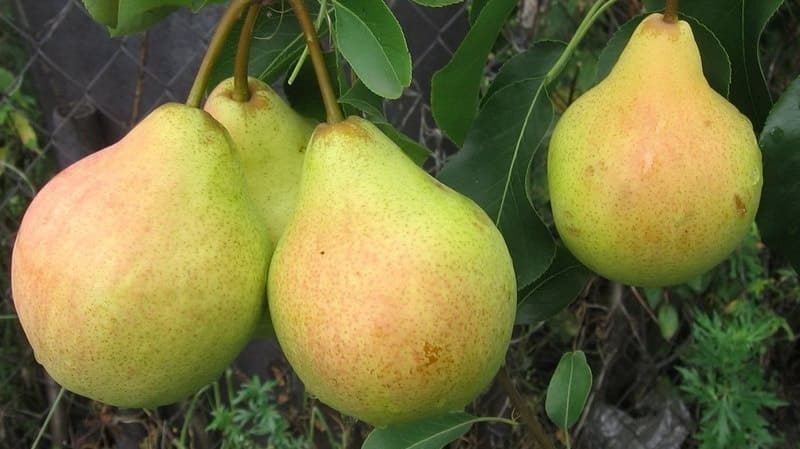
Evgeniy, Nizhny Novgorod: “I grow several varieties of pears in the garden, including Autumn Yakovleva. I don’t bother too much with pruning, I just cut off thickened branches. The trees began to bear fruit 7 years after planting. Withstands frosts down to −40°C. In dry years it produces small fruits, but just as tasty.”.
Vasily, Borisoglebsk: “This variety of pears has been growing in my garden for 15 years and is actively bearing fruit.I don’t have any particular complaints, except that the tendency to scab spoils the picture a little. Knowing this feature, I carry out preventive treatment with Bordeaux mixture and spray it with “Skorom” before flowering. Pears are very tasty, sweet and easy to eat. Pulp without grains. The aroma is not bright, but for me the taste is more important".
Conclusion
Autumn Yakovleva is a domestic pear variety adapted for cultivation in regions with warm and temperate climates. The plant has a low level of frost resistance, but according to some reviews it can withstand frosts down to −40°C. Partial self-fertility forces gardeners to plant trees near the pollinating varieties Avgustovskaya and Lada. The taste of the fruit is excellent: the pulp is sweet, oily, without grains.
Tall trees are pruned to form a crown and prevent thickening of the branches. Susceptibility to scab requires preventive treatments with Bordeaux mixture and fungicides.